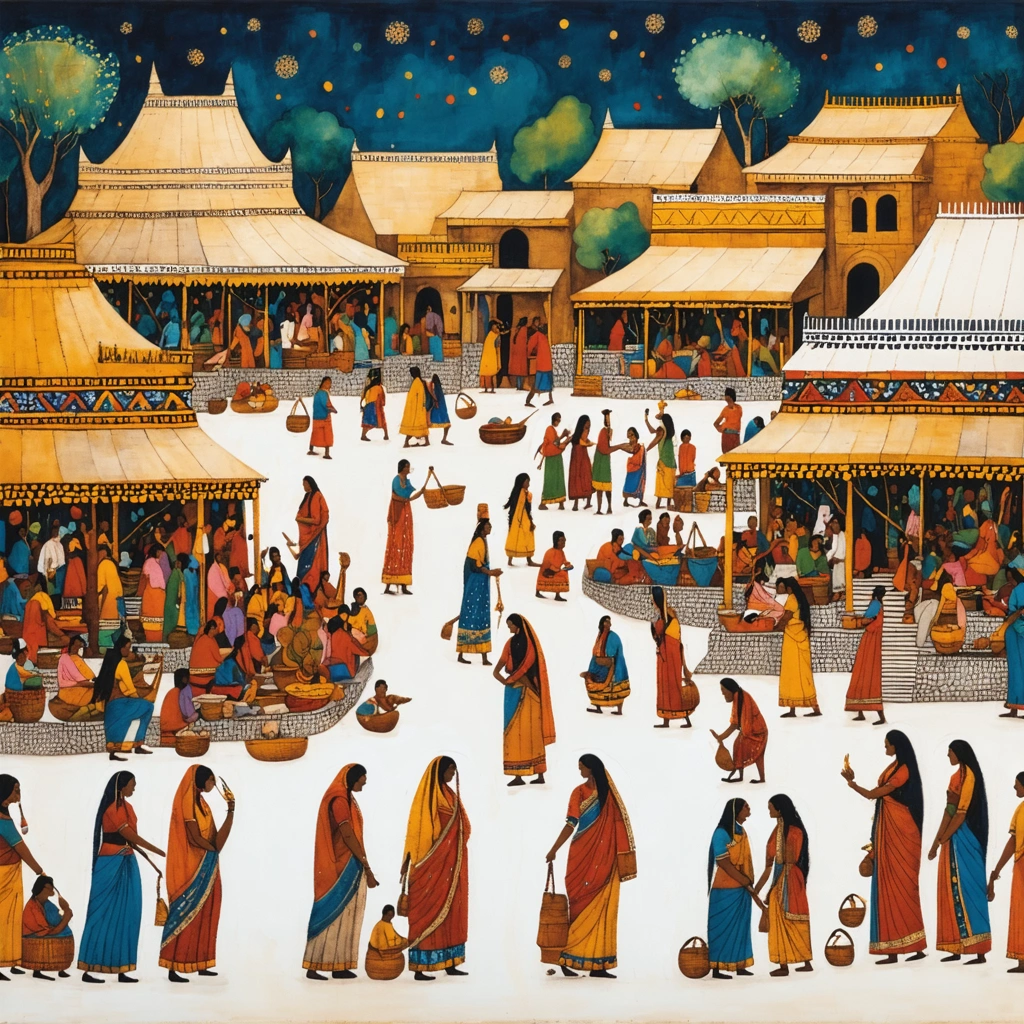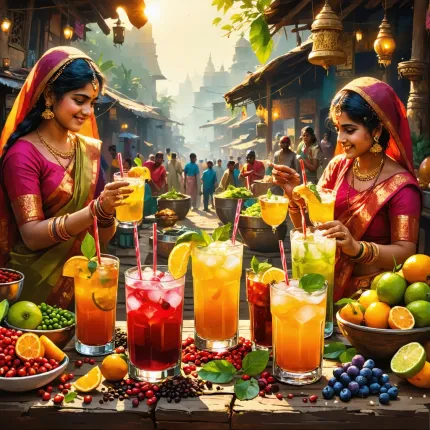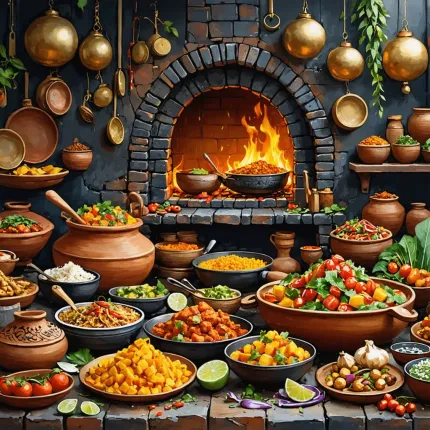
Rediscovering the Lost Treasures of Indian Artistry
Imagine walking through a bustling Indian bazaar where every stall bursts with colors, textures, and stories centuries old. You pause before a delicate canvas depicting scenes from royal courts, another adorned with vibrant geometric patterns, and yet another echoing the rhythms of tribal life. This isn’t just art—it’s a living testament to India’s diverse cultural heritage. Yet, in an era dominated by mass production and digital distractions, these intricate creations risk fading into obscurity. How often do we stop to appreciate the painstaking skill behind a Patna Kalam Painting, the symbolic richness of a Madhubani Painting, or the raw authenticity of Warli Painting?
In 2025, as the world increasingly values authenticity and handmade artistry, there’s a renewed urgency to recognize and support the regional crafts that embody India’s soul. These crafts are not mere souvenirs; they are narratives woven by generations of artisans whose hands carry the legacy of their ancestors. But why does this matter to us today? Because behind every brushstroke and pattern lies a story of resilience, innovation, and identity that deserves to be celebrated and preserved.
The Challenge Facing India’s Regional Artisans Today
Despite the global fascination with Indian crafts, many artisans grapple with challenges that threaten their livelihoods and traditions. Rapid urbanization, changing consumer preferences, and the onslaught of cheaper, machine-made alternatives have marginalized these crafts. The subtle charm of Patna Kalam Painting, known for its fine brushwork and royal themes, struggles to find a market beyond niche collectors. Madhubani Painting, with its bold colors and mythological motifs, often gets reduced to mere decorative prints, losing the cultural context that makes it so profound. Meanwhile, Warli Painting—a tribal art form born from the forests of Maharashtra—faces the risk of becoming a commercialized caricature of its authentic self.
What’s more, younger generations in artisan communities are drifting away from these crafts in search of more stable incomes, leaving behind an invaluable cultural heritage at risk of extinction. Without timely intervention and broader awareness, these regional crafts might become museum relics rather than vibrant, evolving art forms.
Embracing the Revival: How We Can Celebrate and Sustain Indian Regional Crafts
Here’s the exciting part: 2025 marks a turning point. There is a growing wave of conscious consumers and cultural enthusiasts who understand that true luxury lies in the hands of artisans. Supporting Patna Kalam, Madhubani, and Warli paintings means more than owning beautiful art—it’s about empowering communities, preserving history, and encouraging sustainable creativity.
This article will take you on a fascinating journey through the heartlands of India’s regional crafts. We’ll explore:
- Patna Kalam Painting: Discover the delicate storytelling style born in Bihar’s royal courts and how it continues to enchant art lovers today.
- Madhubani Painting: Dive into the vibrant world of Mithila’s women artists whose symbolic motifs narrate stories of nature, mythology, and human life.
- Warli Painting: Experience the primal connection to nature and community expressed through the minimalist yet profound tribal art form from Maharashtra.
Along the way, we’ll share how modern initiatives are bridging the gap between tradition and innovation, enabling artisans to thrive in the contemporary marketplace without compromising authenticity. Whether you are an avid collector, a cultural traveler, or simply someone curious about the rich tapestry of Indian craftsmanship, this deep dive promises insights, inspiration, and an invitation to become part of a movement that honors India’s artisanal heritage.
So, ready to savor the craftsmanship of India’s regional artisans? Let’s embark on this colorful, textured journey together.

Regional Crafts of India: Savor the Craftsmanship of India’s Regional Artisans in 2025
What are the distinctive features of Patna Kalam Painting and why is it significant?
Patna Kalam Painting, also known as Patna School of Painting, is a unique style of Indian art that flourished in the 18th and 19th centuries in the city of Patna, Bihar. Unlike traditional Mughal paintings, which heavily emphasize royal and court scenes, Patna Kalam focuses on everyday life, festivals, and local customs of Bihar’s people.
The significance of Patna Kalam lies in its vivid portrayal of socio-cultural life combined with exquisite brushwork. This style uses watercolors and ink on paper or mica, characterized by simple backgrounds and fine detailing of figures and expressions.
In 2025, Patna Kalam is witnessing a revival as artisans blend traditional techniques with contemporary themes, gaining international appreciation. Efforts by cultural organizations and government schemes have helped sustain this heritage craft, making it a vital part of India’s regional craft narrative.
How does Madhubani Painting reflect the cultural ethos of its region?
Madhubani Painting, originating from the Mithila region of Bihar, is one of the most celebrated folk arts of India. This craft is traditionally practiced by women and is deeply rooted in the cultural and religious practices of the region.
What sets Madhubani Painting apart is its use of natural dyes and pigments, intricate geometric patterns, and symbolic motifs such as peacocks, fish, and deities. The paintings are typically created on walls and floors during festivals and auspicious occasions but have now expanded to paper, cloth, and canvas.
In 2025, Madhubani Painting continues to thrive due to its vibrant colors and meaningful storytelling. It is not only a form of artistic expression but also a means of preserving local myths and community values, making it an important craft for cultural identity and economic empowerment of rural artisans.
What makes Warli Painting a unique tribal art form, and how is it evolving?
Warli Painting originates from the Warli tribe in Maharashtra and is recognized for its simplistic yet profound depiction of tribal life, nature, and rituals. Created using white pigment on mud or dark backgrounds, Warli art employs basic geometric shapes such as circles, triangles, and squares to narrate stories of hunting, farming, and social events.
This tribal art holds immense cultural significance as it serves both decorative and ritualistic purposes. Its minimalistic style, with deep symbolism, connects the community to their natural surroundings, fostering a sense of identity and continuity.
By 2025, Warli Painting has expanded beyond traditional walls into modern mediums like textiles, home décor, and digital art. This evolution helps preserve its authenticity while making it accessible to global audiences and providing sustainable livelihoods for the Warli artisans.
Why should one explore the regional crafts of India in 2025?
Exploring India’s regional crafts like Patna Kalam Painting, Madhubani Painting, and Warli Painting offers a rich journey through the country’s diverse cultural heritage. These crafts are more than just artistic expressions; they encapsulate histories, traditions, and the social fabric of their respective regions.
In 2025, there is a growing global appreciation for handcrafted and sustainable products, which aligns perfectly with these traditional arts. Supporting regional artisans helps preserve endangered crafts, empowers rural economies, and promotes cultural tourism.
Additionally, learning about these crafts provides insight into the techniques, materials, and stories behind each piece, enhancing appreciation for handmade art as opposed to mass-produced goods.
How can one support and engage with these regional artisans and their crafts?
Engagement with regional crafts and artisans can be done through various meaningful channels:
- Purchasing authentic handmade products: Buying directly or through verified platforms ensures fair payments to artisans.
- Visiting craft villages and workshops: Experiencing the making process fosters a deeper connection and understanding.
- Participating in craft fairs and exhibitions: Events dedicated to Indian crafts offer opportunities to discover new styles and meet artisans.
- Supporting governmental and NGO initiatives: Many organizations work towards preserving crafts and providing artisan training.
- Promoting crafts on social media and blogs: Sharing stories and artworks helps increase visibility and market reach.
By actively engaging with these crafts, individuals contribute to the revival and sustainability of India’s rich artisanal heritage.
What trends are shaping the future of India’s regional crafts in 2025?
Several key trends are influencing the trajectory of regional crafts such as Patna Kalam, Madhubani, and Warli Painting:
- Fusion with contemporary art and design: Artisans are collaborating with designers to create products that appeal to modern aesthetics while retaining traditional elements.
- Use of eco-friendly and sustainable materials: There is a conscious shift towards natural dyes, recycled materials, and environmentally responsible production.
- Digital marketing and e-commerce platforms: Artisans and cooperatives are leveraging online channels to reach global customers directly.
- Government support and craft education: Increased funding and skill development programs are helping artisans improve craft quality and market access.
- Experiential tourism: Craft trails and immersive workshops are becoming popular among travelers seeking authentic cultural experiences.
These trends not only ensure the survival of traditional crafts but also make them relevant and desirable in the modern marketplace.
Conclusion: Embracing the rich legacy of India’s regional crafts in 2025
The regional crafts of India, epitomized by Patna Kalam Painting, Madhubani Painting, and Warli Painting, offer a vivid window into the country’s diverse cultural heritage and artisanal mastery. As these crafts evolve and adapt to contemporary contexts, they continue to celebrate India’s artistic traditions and sustain the livelihoods of countless artisans.
In 2025, savoring these crafts means appreciating the intricate stories, techniques, and cultural significance they embody. By supporting and engaging with these crafts, one contributes to a vibrant ecosystem that honors the past while innovating for the future.


